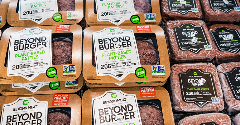News
Trend Watch: Oral Health
23 Jul 2013According to Euromonitor International research, oral health is the sixth most popular positioning platform for health and wellness-oriented foods and beverages. We take a look at some potential new opportunities, including how the all-powerful natural trend may pave the way for the emergence of a new crop of functional oral health ingredients, like berry and […]

According to Euromonitor International research, oral health is the sixth most popular positioning platform for health and wellness-oriented foods and beverages. We take a look at some potential new opportunities, including how the all-powerful natural trend may pave the way for the emergence of a new crop of functional oral health ingredients, like berry and liquorice extracts and coconut oil.
Oral health foods and beverages approach annual sales of US$20 billion
In 2012, foods and beverages with an oral health primary positioning accrued global value sales of US$18.5 billion. This figure is none too shabby when considering that sales of cardiovascular health-positioned products managed to reach just US$8 billion. Energy boosting, in comparison, reached nearly US$29 billion owing to the omnipresence and rampant global uptake of energy drinks.
In terms of growth, oral health primary-positioned products delivered a respectable performance. Over the 2007-2012 review period, global value sales rose by 32%, surpassing weight management-positioned products’ more subdued 27% growth trajectory.
What works and what doesn’t?
February 2013 saw the publication of a very interesting study in the International Journal of Dental Hygiene, scrutinising almost 600 clinical trials which tested the efficacy of sugar-free gum laced with a number of different active ingredients meant to control plaque and gum disease.
According to this study, the one ingredient which stood out for its efficacy was the antimicrobial agent chlorhexidine, which has long been used in medicated mouthwashes and other oral care products to fight oral disease. The other ingredients under assessment were mastic, pycnogenol, funoran, eucalyptus, acacia, hydrogen peroxide, magnolia bark extract, urea and zinc gluconate. Only the latter two did not show as having any noticeable effect, giving manufacturers plenty of scope to employ the other options in their NPD efforts.
Competition for xylitol?
Xylitol, a naturally-occurring sugar widely used in gum and marketed as protecting against cavities, may soon have some serious competition from erythritol, another type of naturally-occurring sugar alcohol.
Agriculture and food ingredients giant Cargill conducted a double-blind, randomised, placebo-controlled study a year ago, which reportedly revealed that the company’s Zerose-branded erythritol sugar was more effective at counteracting dental caries and plaque reduction than xylitol and the even more commonly employed sorbitol. Cargill is convinced that Zerose erythritol ‘will become a major point of difference in the marketplace’ for oral health-positioned products.
Natural’s the word
In autumn of last year, the Irish-based Athlone Institute of Technology presented intriguing research at the Society for General Microbiology conference held at the University of Warwick, showing that enzyme-modified coconut oil prevented caries-causing bacteria from adhering to tooth enamel. The enzyme modification technique employed is very similar to what would happen to coconut oil during the natural digestion process.
Not only does this mean that coconut oil sports exciting potential as a ‘natural’ ingredient in oral health-positioned food and beverage products, but the researchers believe that a range of enzyme-modified ingredients are just as capable of producing the same oral health benefits. Milk protein had already been tested by the team, and with positive results.
Another possible natural weapon in the fight against tooth decay comes from the domain of Traditional Chinese Medicine, in the form of liquorice root. A study published last year in the American Chemical Society’s Journal of Natural Products identified two components found in the root – licoricidin and licorisoflavan A – both of which were capable of killing tooth decay-causing bacteria.
Furthermore, a preliminary study carried out by Ohio State University early this year also provides a possible pointer to a new direction for oral health ingredients. The researchers looked at berries, which are currently hugely popular ingredients in a wide range of health and wellness-positioned products. The study found that anthocyanin-rich extracts procured from blueberries, chokeberries, blackberries, red grapes and strawberries appeared to confer oral cavity-protective benefits.
Much more research will be required in this field, but this development could quite feasibly fuel an emerging trend in fruit extract-based gums and confectionery positioned on an oral health platform.
Kraft innovation set to overhaul tooth whitening confectionery?
On the tooth whitening front, Kraft Foods filed a promising patent in December 2012. The company has developed a proprietary encapsulation technology which allows peroxides to be delivered in chewing gum format. Peroxides have so far failed to prove themselves as a viable ingredient in tooth whitening gums because they interact with the gum base and degrade rapidly.
Kraft envisages that this new technology will also find application in types of sugar confectionery other than gum, particularly in chewable candies. This could potentially lead to some welcome product diversification as oral health benefits (besides breath freshening) are at the moment mainly confined to the realm of gum.
Euromonitor International estimates that by 2017 the oral health category will muster annual sales of US$20.8 billion, equating to a 12% increase on 2012 sales.
Related news

PepsiCo formulates ‘naked’ Cheetos and Doritos products
31 Dec 2025
US food giant PepsiCo has launched its Simply NKD range, a move it says reimagines its popular products with new formulations free from artificial flavours, dyes, and colours.
Read more
Debate over ban on ‘meaty’ names for plant-based products reaches stalemate
26 Dec 2025
The debate over a ban on plant-based products using “meaty” terms has reached a stalemate, leaving manufacturers in limbo and still facing overhauls to their marketing and packaging.
Read more
Has ‘clean’ had its day?
22 Dec 2025
Wielding clean-label positioning and fortification as marketing levers is a dangerous strategy, and brands would be better off explaining the hows and whys of the ingredients in their products, say experts.
Read more
Pioneers of circular plastic packaging push for new policies
18 Dec 2025
Some of the world’s largest food and drink companies have grown frustrated at investing in circular packaging systems, as the majority “wait on the sidelines”.
Read more
Whole Foods Market forecasts fibre frenzy for 2026
11 Dec 2025
Whole Foods Market has released its top 2026 trends, predicting that a fibre frenzy will take place next year as health-conscious consumers seek out nutritious, filling options.
Read more
Sorghum emerges as better-for-you hero ingredient
9 Dec 2025
With the launch of Novak Djokovic’s sorghum-based brand, the grain’s popularity in the better-for-you snacking sphere is on the rise, thanks to its nutritional and sensory properties.
Read more
Innovation promise in 'maturing' plant-based dairy alternatives market
8 Dec 2025
Plant-based dairy is a maturing market that still faces significant hurdles around taste, functionality, nutrition, and price, but industry is innovating fast, according to experts speaking at Fi Europe.
Read more
Turning global trade challenges into opportunities
4 Dec 2025
While our food innovation ecosystem is in a healthy place, certain barriers persist. A panel of experts at Fi Europe shared their ideas and strategies for overcoming these, to fully unleash Europe’s potential.
Read more
Celebrating the winners of the Fi Europe Innovation Awards 2025
3 Dec 2025
Food industry stakeholders celebrated as the winners of the Fi Europe Innovation Awards were announced at a ceremony in Paris.
Read more
Yuka’s food scanning app helps consumers make healthier choices
2 Dec 2025
Global food scanning app Yuka helps consumers understand the content of their shopping baskets and shapes producers’ reformulation plans.
Read more